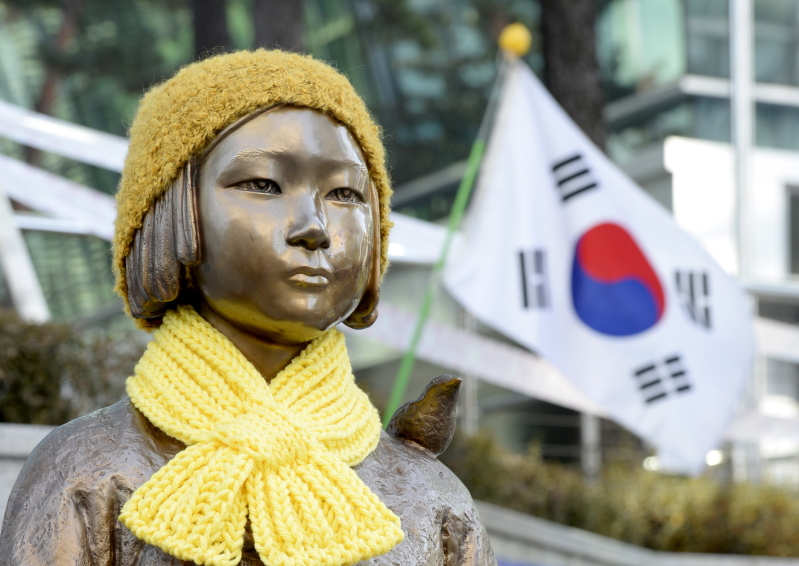
One test of the commitment by Japan and South Korea to resolve the "comfort women" issue may be the fate of a statue in front of Tokyo's embassy in Seoul.
The bronze of a barefoot teenage girl in a traditional handbook dress, sitting on a chair with fists clenched on her lap and an empty chair beside her, has become a symbol of "comfort women", as those who were forced to work at Japan's wartime military brothels are euphemistically known.
For many Japanese officials, the presence of the 1.5 meter statue in front of the embassy is a symbol of South Korea's unwillingness to lay the issue to rest as well as an affront to its national dignity that should not be permitted by Seoul.
"It is not something that friendly nations normally do," said a former Japanese diplomat with experience in East Asia, asking not to be identified.
"Every Wednesday they have gatherings there protesting on the question of comfort women, in front of the embassy, and that reminds everyone, and that is not good," the former Japanese diplomat told Reuters.
The two countries signed a landmark agreement on Monday to resolve the "comfort women" issue. Although South Korea did not agree to remove the statue, Foreign Minister Yun Byung-se said Seoul recognizes Japan's concerns and will hold discussions with the group that erected it to address the problem.
But it will take an act of political courage in Seoul to relocate the artwork, which has served as a potent symbol of Japanese wartime aggression.
The group behind the statue, the Korean Council for the Women Drafted for Military Sexual Slavery by Japan, rejected Yun's comments as "disgraceful" and "appalling."
"We make it clear that the statue cannot be a condition for any kind of agreement or a tool," the group said in a statement. "It is unacceptable for the government to talk about taking down or moving the statue."
When it was erected in 2011, the statue galvanized public calls for Japan to make a fresh apology and properly compensate the victims.
"NOT INTIMIDATING"
The sculptors who created the bronze statue said they had been inspired by the decades-long struggle by "comfort women" seeking recognition and compensation.
"The statue is not intimidating at all. It is a girl sitting quietly there," Kim Seo-kyung, a sculptor who built the statue with her husband, told Reuters. "Look at Germany. They apologize almost every day but Japan is talking about removing the statue at the negotiation table?"
Ahn Shin-kwon, director of the House of Sharing, home to 10 of the surviving women, said: "The statue should be there forever to remember the past."
Japan will be looking to South Korea to accomplish the statue's removal, but may be willing to give Seoul time.
"They (the civic group) have the right to resist because they were not fully involved in the agreement. But this is the job of the administration in Seoul," said former Japanese diplomat Kunihiko Miyake.
"Is it a test? It is part of the deal, it's a package, but it's not simultaneous, it's phased."
Scholars continue to debate the number of women exploited. Activists in South Korea say there may have been as many as 200,000 Korean victims, only a few of whom came forward.
There are 46 surviving "comfort women" in South Korea, out of the 238 who had come forward to share their stories of abuse, many taken from their homes when they were in their teens and forced to work as sex slaves.
On Monday, the statue had a yellow woollen scarf around the neck and a brown cap on its head. The empty chair next to her symbolizes fellow victims who have passed away, said Kim, who spent about eight months to create the statue.
"Like the victims, the girl is not weak or too angry but is strong and never ashamed, looking at the Japanese embassy."







